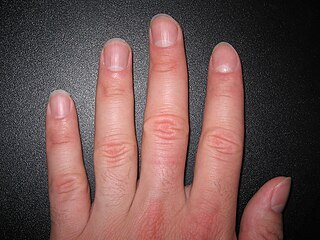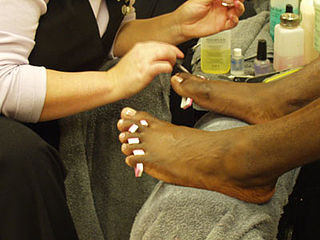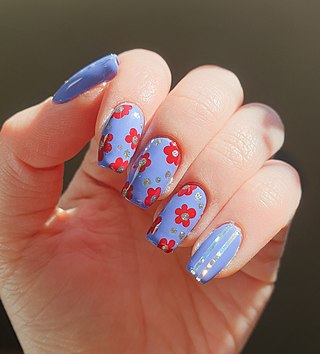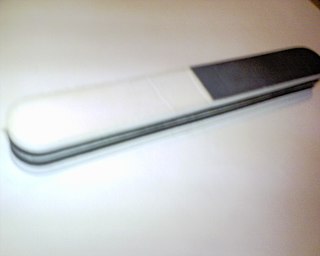
Paraffin wax is a soft colorless solid derived from petroleum, coal, or oil shale that consists of a mixture of hydrocarbon molecules containing between 20 and 40 carbon atoms. It is solid at room temperature and begins to melt above approximately 37 °C (99 °F), and its boiling point is above 370 °C (698 °F). Common applications for paraffin wax include lubrication, electrical insulation, and candles; dyed paraffin wax can be made into crayons. It is not to be confused with kerosene and other petroleum products that are sometimes called paraffin.

A nail is a protective plate characteristically found at the tip of the digits of all primates, corresponding to the claws in other tetrapod animals. Fingernails and toenails are made of a tough rigid protein called alpha-keratin, a polymer also found in the claws, hooves and horns of vertebrates.

A pedicure is a cosmetic treatment of the feet and toenails, analogous to a manicure.

Cosmetology is the study and application of beauty treatment. Branches of specialty include hairstyling, skin care, cosmetics, manicures/pedicures, non-permanent hair removal such as waxing and sugaring, and permanent hair removal processes such as electrology and intense pulsed light (IPL).

Nail polish is a lacquer that can be applied to the human fingernail or toenails to decorate and protect the nail plates. The formula has been revised repeatedly to enhance its decorative properties, to be safer for the consumer to use, and to suppress cracking or peeling. Nail polish consists of a mix of an organic polymer and several other components that give it colors and textures. Nail polishes come in all color shades and play a significant part in manicures and pedicures.

A beauty salon or beauty parlor is an establishment that provides cosmetic treatments for people. Other variations of this type of business include hair salons, spas, day spas, and medical spas.
A nail file is a tool used that can be used to gently grind down and shape the edges of nails. They are often used in manicures and pedicures after the nail has been trimmed using appropriate nail clippers. Nail files may either be emery boards, ceramic, glass, crystal, plain metal files or metal files coated with corundum.

An acrylate polymer is any of a group of polymers prepared from acrylate monomers. These plastics are noted for their transparency, resistance to breakage, and elasticity.

A nail salon or nail bar is a specialty beauty salon establishment that primarily offers nail care services such as manicures, pedicures, and nail enhancements. Often, nail salons also offer skin care services. Manicures are also offered by general beauty salons, spas, and hotels. People who work at nail salons are usually called nail technicians, manicurists, or nailists.
Personal care products are consumer products which are applied on various external parts of the body such as skin, hair, nails, lips, external genital and anal areas, as well as teeth and mucous membrane of the oral cavity, in order to make them clean, protect them from harmful germs and keep them in good condition. They promote personal hygiene and overall health, well-being and appearance of those body parts. Toiletries form a narrower category of personal care products which are used for basic hygiene and cleanliness as a part of a daily routine. Cosmetic products, in contrast, are used for personal grooming and beautification. Pharmaceutical products are not considered personal care products.

Nail buffing is the act of polishing the nail using buffers of successively finer grit in order to make nails look more consistent and shiny. A paste is used to fill ridges on nail surfaces.
Onychoschizia, also known as nail splitting and brittle nails, is a splitting of the free-edged tip of the nail. There is also often a longitudinal split in addition to the separation of keratin layers.

Artificial nails, also known as fake nails, false nails, acrylic nails, nail extensions or nail enhancements, are extensions placed over fingernails as fashion accessories. Many artificial nail designs attempt to mimic the appearance of real fingernails as closely as possible, while others may deliberately stray in favor of an artistic look.

A nail technician or nail stylist is a person whose occupation is to style and shape a person's nails. This is achieved using a combination of decorating nails with coloured varnish, transfers, gems or glitter. Basic treatments include manicures and pedicures, as well as cleaning and filing nails and applying overlays or extensions.

Mary E. Cobb was the first known American manicurist and introduced modern nail manicuring to Britain and the United States.
A glass nail file is a nail file with an abrasive surface made of glass, that is used to gently grind down and shape the edges of fingernails. They are often used in manicures and pedicures after the nail has been trimmed using nail clippers.
Water marble nails are a finger nail art technique involving dropping nail lacquers into clear water and creating a pattern on the water surface; the pattern is then transferred to the nails.

Nail art is a creative way to paint, decorate, enhance, and embellish nails. It is a type of artwork that can be done on fingernails and toenails, usually after manicures or pedicures.
A migrant nail salon worker is a nail technician, manicurist, esthetician, or masseuse working in a Migrant, often Asian–owned nail salon in America. These workers are typically women who have immigrated from South Korea, though there are also Latina and Chinese immigrants employed by these shops. The majority of women who work in these nail salons are paid low wages, exposed to dangerous chemicals because of weak regulations, and develop complicated relationships with their clients, largely due to language differences and contradicting views on what constitutes quality customer service. Most Korean-owned nail salons are located in New York, and in reaction to a 2015 New York Times exposé documenting corruption within the state's nail salon industry, Gov. Andrew Cuomo created the New York State Nail Industry Enforcement Task Force, and signed into law stricter salon regulations and required the posting of wage bonds.

Jenny Bui is a Cambodian-American nail artist known for her crystal-studded creations. She was named Nail Artist Influencer of the Year in 2019 and is known as "The Queen of Bling."























